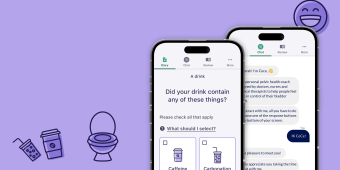6 steps to getting better software for healthcare providers

If you’ve been working in medicine for decades, it can be a bit of a shock when all of the sudden you’re tasked with building software for healthcare providers. It’s an entirely new discipline, with different possibilities, different norms, even a different language.
The truth, though, is that the best hospital software starts with you.
Need to bridge the gap between you and your healthcare software provider? Here’s how
At Table XI, our practice depends on user-centered design — understanding the users, and putting their needs at the core of anything we build. That method doesn’t stop at consumer products. When we work on software in healthcare, it’s the practitioners and administrators and even patients that now become our users. We need to know as much about how you work as possible, so we can figure out the best places for technology to slot in and improve your day-to-day. That also means we need you to know what parts of your day are unnecessarily challenging, and what you’re hoping technology can do for you.
Because it can be so hard to communicate between healthcare and tech, a lot of healthcare workers end up shutting down, pouring requirements into an RFP, and leaving it to the software company to figure the rest out. But all that does is result in more of the same clunky, not-quite-right software. Whether you’re adopting off-the-shelf healthcare software or building a custom application, before you embark on a healthcare software project, consider taking these six steps to create a shared vision and define your goals.
Get your team talking about what software for healthcare can do
Having everybody list their needs for a new piece of medical software is like asking a group of blind people to identify an elephant by touch. You’ll end up with a snake for the trunk, a tree for the legs, and no clear picture of what you actually need to be developing.
To avoid ending up with a hodgepodge of features that feels like design by committee, start by getting your team to at least agree that they need to agree. Then, set a series of recurring meetings (they’re harder to skip) with your stakeholders, so you can hammer out the details using the following steps before you start the project.
Make sure everyone understands that healthcare software can’t cure everything
Healthcare software products are oftentimes seen as panaceas. You’ll hear people rattle off lists of all the things the new system will take care of, but if you ask how it will take care of those things, no one can really tell you.
Defining a medical software system as pretty much only “not what they have right now” won’t give you a product roadmap. And projecting everyone’s hopes and dreams onto the software sets an impossibly high bar for success. No finished product can live up to that hype. Before you even reach out to software vendors for healthcare, work with your team internally to set expectations.
Start small, and don't over-specify what healthcare software applications should do
When we’re trying to avoid making healthcare industry software a panacea, it’s easy to take the opposite tack, getting incredible specific and scoping out every single thing the software will, and won’t, do.
Fight that urge. You don’t want to spend a ton of time defining something, only to find out that it’s technologically not possible, or too expensive, or just not the right fix.
Choosing between healthcare software companies? What to know
At the same time, you do need to be specific enough about what the product will do to make it accomplishable. Start small, otherwise you run the risk of building a Swiss army knife when what you need is a scalpel. Software is just a tool, and no tool can solve everything for everyone. The trick is to figure out what the common denominator is among people’s needs, then build that.
We recommend taking an Agile approach to developing software used in healthcare, instead of a Waterfall approach. With Agile, you build, learn, adapt, build again and repeat. With Waterfall, you do all of your planning up front, and you have no way to respond if something doesn’t go according to those plans. This is why we advise clients not to write an RFP. Talk with a bunch of software development companies, sure, and find the best fit, but don’t create a list of everything you need. You’ll end up with features that aren’t informed by the available technology, and you’ll get back huge, unaffordable bids. Just start with a little piece of work and let it grow.
Use prototypes to agree on the best hospital software
Remember that metaphor about trying to identify an elephant? If no one can see what you’re building, no one can agree. The sooner you can make it real, the better. A napkin sketch is better than an idea in two people’s heads, a lo-fi prototype is better than that and a working prototype is best of all.
The tricky thing about healthcare software programs is that everyone has such highly specific needs. It’s very hard to communicate those needs and make them all line up unless you’re working with something that has a tangible reality. Find a way to make the ideas visible and put them in front of the room, because that’s the only way to really know that everyone is in agreement.
Open up to the fact that software for healthcare providers often triggers process and people changes
At the same time, one of the best things medical software programs can do is give you a reason to change up staffing and processes that just aren’t working. That’s the dirty secret of healthcare software consulting — we’re often using technology as a vector to introduce solutions to people and process problems.
The software is only as good as the healthcare system it’s working in. Be open to the idea that to get the best results, you may also need to embrace bigger process changes. It’s much more comfortable to blame the software than it is to point fingers, so use the software as an excuse to undo systems that aren’t working.
Get real healthcare software solutions by saving tech for what it does best
Even the fanciest healthcare software technology is still just a tool. In the same way a defibrillator on the wall can’t stop a heart attack, your software can’t run things alone. As you plan out what you want the software to do, think about the things computers do really well — handle large amounts of data, be precise, stay consistent. And then remember the things people are much better at — pattern recognition, empathy, listening.
Don’t ask a machine to do a person’s job. Event the most cutting-edge AI can’t give meaning to tiny, important differences as well as experienced people. The tech should complement the people — think medical record-keeping software, healthcare management software, administration software, etc. When you’re thinking through the solution, have a clear idea of where the tool stops and the human mind takes over.
… And save healthcare software companies for what they do best
If you bring on a company to build your healthcare software before you have a sense of what it should look like, nine times out of ten they’re going to end up building what’s easiest or most interesting for them. It’s not their fault, necessarily, it’s just that there’s a void, and they have to fill it.
How to find — and work with — a healthcare software company that won’t mislead you
If you go in with a clear picture of your own needs, however, and questions about how companies can use tech to solve them, you’ll be much better equipped to pick the right firm and build the right product.
You’ll also know what success looks like. When you’re deep into building software for healthcare, it can be easy to forget why you’re putting in this effort. By following the above steps, you’ll know what software in healthcare can do, what you’ll get out of it when it launches, and what you may get out of it in the future. It gives you something to look forward to, and a bar the product has to clear before you can call it a success.
Want to clear that bar? We’ve worked with several healthcare providers to build apps for everything from communication to education to gamification.
Published by TXI Healthcare in Digital Health

Let's shape your insights into experience-led data products together.



